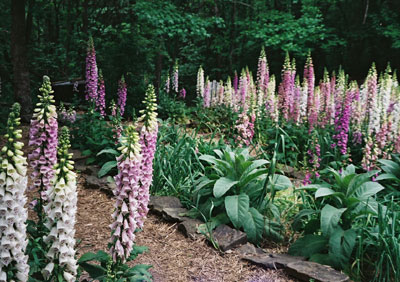
Lush foxgloves, photo by Paula
One packet of seeds purchased in the early 1990s has brought a forest of foxgloves into our lives. At the time, I was operating Everlastings Etcetera where I was growing and crafting dried flowers and herbs. I poured over seed catalogues and books looking for information and possibilities. Mark and Terry Silber’s book The Complete Book of Everlastings is still my favorite resource about drying flowers and herbs. I knew that foxgloves could not be dried, but I wanted to experience the beauty of those tall spires of bell shaped flowers. I started flats and flats of seedlings and then planted them outside as the weather permitted.
With so much to do as I grew and harvested, then crafted wreaths and bouquets that I marketed at craft fairs and the farmer’s market, I neglected my foxglove seedlings. The everlastings were my bread and butter. By August I was desperate for help with planting the overgrown foxglove plants still in the seedling trays. As a birthday request, I asked Jeanne for help in getting them moved into the ground. The foxgloves were amazingly tolerant of the crowded conditions and the delayed move to a permanent home. Most of them thrived in the eastern exposure where they are protected from the hottest of the afternoon sun.
As biennials the plants must go through one winter before they bloom. In early May, Jeanne and I were rewarded with dramatic spires of long lived flowers in shades of white, pink, lavender and magenta. Each individual flower throat was marked with dark dots leading the way for fat, buzzing bumblebees to drink their nectar.
Foxgloves are prolific self-seeders if you leave the stalks in place long enough to set seeds. For the past fifteen years we have allowed the foxgloves to wander where they will. The seedlings seem to thrive at the base of the rock walls we use to retain the soil of our raised beds. Other exotic tall flowers with spires that I have tried to nurture along are delphiniums and bells of Ireland with no success–probably because of our hot summers.
Foxgloves are one of our garden successes. I have developed a gardening philosophy that embraces success. Rare specimens of individual plants do not usually intrigue me. I’d rather have lush groupings of ordinary plants with the emphasis on lush. With this philosophy, I can gather large cuttings of ordinary mint to scent the house. My eyes can feast on masses of a self-seeding dark green hosta or wild ferns like the maidenhair fern and christmas fern that thrive in our woods. I can pot up seedlings of the volunteer hostas and gather up seeds from the foxgloves to share with friends. Some gardeners regard self seeding plants as unwanted additions, and sometimes they are–for example perilla. But I consider foxgloves and others to be durable goods for the garden. Plant sellers want you to return again and again for their products. Why not grow your own whenever you can?
I use masses of ordinary plants who often chose new settings for themselves. These new combinations of textures put together by Mother Nature can delight the eye. You can see in the photo below how the huge wild mullein leaves add a silver grey texture among the foxgloves. The mullein plants volunteered in that spot. I do weed out some uninvited visitors, seeing my action as a form of editing. A tightly controlled garden does not appeal to me. Each spring can bring new adventures and discoveries especially when we welcome the abundance that self-seeding plants offer us.

Path among the blooms, note the large mullein leaves, photo by Paula


It’s been lovely spending an hour reading the new blogs. I love reading both of your blogs.
Comment by Susan Wiseheart — May 22, 2009 @ 6:17 am
Thank you for your blog post.Thanks Again. Cool.
Comment by Aimee Ahmad — January 9, 2012 @ 2:57 am